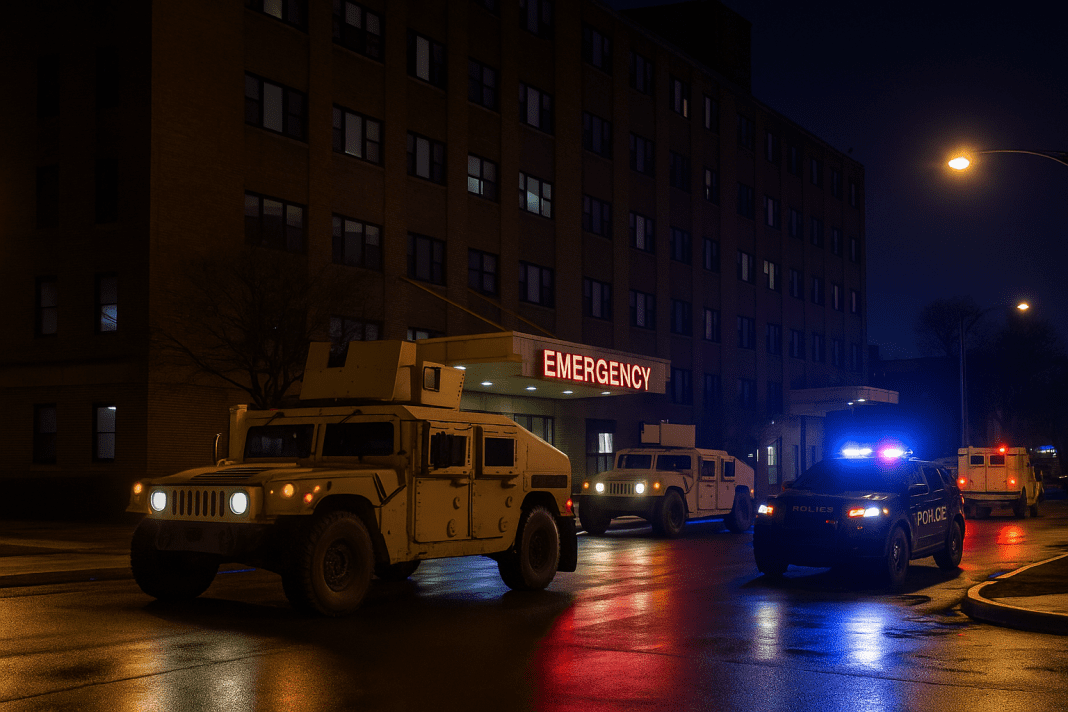Chicago’s southwest side turned into a flashpoint of violence on Saturday as U.S. Border Patrol officers shot an armed woman during a fierce standoff between protesters and federal immigration agents. The Department of Homeland Security (DHS) confirmed that the woman, a U.S. citizen carrying a semi-automatic gun, was injured after a clash in the Brighton Park neighborhood.
According to DHS spokesperson Tricia McLaughlin, the confrontation escalated when a group of protesters, including the woman, rammed their vehicles into cars belonging to Immigration and Customs Enforcement (ICE). No federal officers sustained serious injuries in the assault. The unidentified woman managed to drive herself to a hospital, though officials released no details on her condition.
As the situation deteriorated, ICE agents fired pepper spray and rubber bullets, while tear gas engulfed the streets. The air was filled with shouting, chaos, and clouds of chemical munitions as demonstrators clashed with heavily armed agents. Reuters images captured flames, tear gas plumes, and officers in full riot gear advancing through the Little Village and Brighton Park neighborhoods.
Federal Crackdown Triggers Political Firestorm
The violence coincided with a political showdown at the highest levels of government. Homeland Security Secretary Kristi Noem announced on social media that she was deploying “special operations units” to Chicago, escalating federal presence in the city.
DHS expands ICE partnerships in the Midwest with new financial incentives to boost local involvement
Illinois Governor JB Pritzker pushed back strongly, denouncing what he described as federal overreach. “It is absolutely outrageous and unAmerican to demand a Governor send military troops within our own borders and against our will,” Pritzker declared in a public statement.
President Donald Trump, however, directly authorized the deployment of 300 National Guard troops to secure federal officers and infrastructure in Chicago. White House spokeswoman Abigail Jackson confirmed the move, stressing that it was necessary to protect federal assets.
The Governor revealed that Trump had issued an ultimatum, demanding National Guard deployment or risk direct federal intervention. The political clash added fuel to already inflamed tensions, with protesters railing against what they described as militarized crackdowns in Democratic-led cities.
In a parallel development, a federal judge temporarily blocked Trump’s attempt to send 200 Oregon National Guard troops to Portland, where protests against federal law enforcement had mirrored Chicago’s unrest.
Streets of Chicago Turn Into Battleground
For several nights leading up to Saturday’s confrontation, hundreds of demonstrators gathered outside ICE facilities across the Chicago area, including in Broadview. Tensions repeatedly boiled over as protesters attempted to physically block ICE transport vehicles from moving detainees.
ICE Accused of Traumatizing Kids Congress Vowed to Protect — ACLU Demands Their Release
Images from the scene showed demonstrators sitting on roads, linking arms, and chanting slogans against ICE detention policies. Agents responded with force—using chemical sprays, rubber bullets, and batons to clear paths. The confrontations evoked combat-like scenes rarely witnessed in American cities outside of declared emergencies.
On Saturday, the escalation reached its peak. Tear gas canisters rolled across pavement as protesters hurled objects and shouted in defiance. Vehicles smashed against federal barricades, while ICE convoys attempted to maneuver detainees through the chaos.
Photographs from Reuters showed tear gas rising like smoke bombs in Chicago’s Little Village neighborhood as federal officers in helmets and shields advanced. Lines of armed agents fired rubber rounds into the crowds, scattering groups of demonstrators who regrouped only to return in waves.
The armed woman who was shot became the central figure of the day’s violence. DHS confirmed she carried a semi-automatic firearm during the clash, though details of her actions immediately preceding the gunfire were not released. Despite being struck, she left the scene in her own vehicle and checked herself into a hospital.
ICE agents smash car window, point guns at family with 1-month-old baby in Colorado
The showdown marked one of the most dramatic escalations in Chicago’s long-running protests against federal immigration enforcement. Communities across the city have continued to challenge ICE’s presence, while the federal government has responded with intensified operations, bringing the conflict into sharper focus on the national stage.
